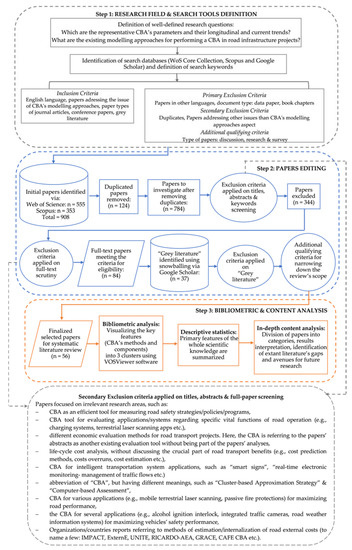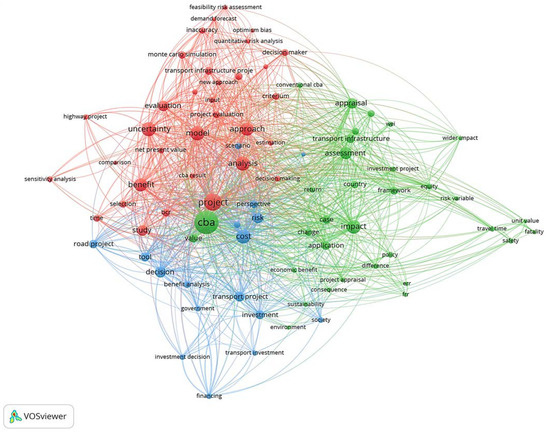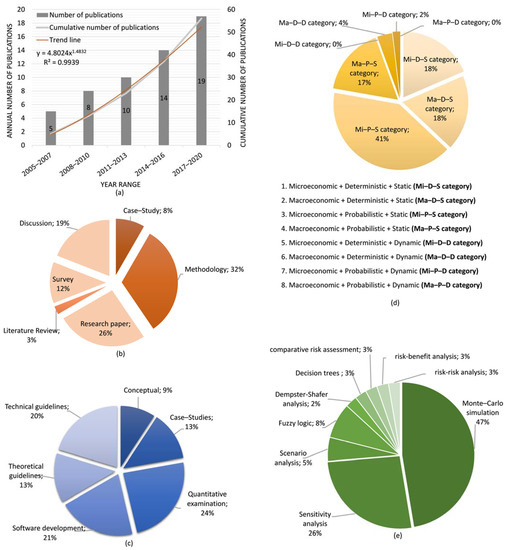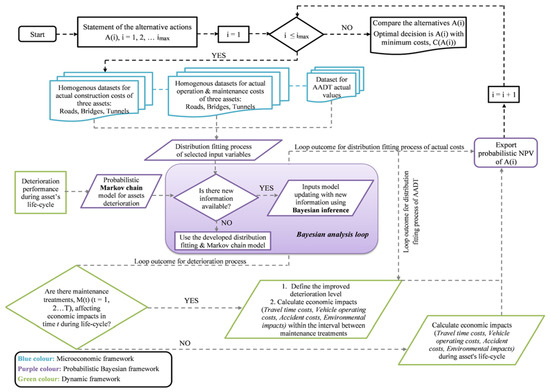Abstract
In-depth content analysis led to the interpretation of the current status of extant models and the identification of three main knowledge gaps:
a) the absence of the CBA’s inputs updating into a probabilistic environment,
b) the deficiency of a dynamic interdependent framework; and
c) the necessity of homogenous cost datasets for road projects.
Future research directions and a conceptual framework for modelling CBA into a microeconomic, probabilistic and dynamic environment are proposed providing decision-makers with new avenues for more reliable CBA modelling.
1. Introduction
2. Systematic Literature Review: Research Protocol and Analysis

Figure 1. Flowchart for presenting the followed steps for conducting the systematic literature review (SLR), bibliometric and content analysis.
Primarily, for the holistic investigation of the current status of CBA’s method of Road infrastructure projectss to be guaranteed, the authors attempted to clarify the well-defined research questions of Figure 1 (step 1: “Research field and tools definition”). The peer-reviewed articles searching was performed by the Web of Science (WoS) Core Collection and Scopus bibliographic databases, which are two of the most widely accepted and well-recognized databases for high-quality bibliometric analysis (BA) [14]. The three-level structure of keywords and Boolean operators used for data mining among the fields of titles, abstracts and authors keywords into the WoS and Scopus are presented in Table Ain Appendix A). The scope was restricted to the English language, including the document types of journal articles and conference proceedings within a timespan between 2005–2020 because it was considered capable of capturing the dynamic evolution of the concepts that influence and develop the research topic’s evolution. The primary exclusion criteria of Figure 1 were applied to the search inside the bibliographic databases. Moreover, the authors practiced snowballing technique by complementarily extending their search into the references lists of the selected full-text papers for identifying non-peer-reviewed “grey literature”, namely government and multiorganizational reports. Grey literature was extracted via the Google Scholar (GS) web search engine.
3. Results Bibliometric Analysis and DescRoad infrastructure projectstive Statistics
The scientifically validated map of Figure 2 was created via VOSViewer for optimizing the ease of conception using the 56 retrieved structured papers. The knowledge domain map was plotted using the keyword co-occurrence analysis (parameter settings: type of data: text data, type of analysis: co-occurrence; counting method: full counting; unit of analysis: all keywords). In detail, the textual analysis identified 83 most frequently stated terms as determinants of the CBA method in the road transport field and distinguished three main cognitive clusters (i.e., green, red and blue), which rendered beneficial for revealing the research topic evolution and answering the first question of Figure 1.
- (a)
-
The type of data risk assessment, i.e., deterministic or probabilistic; the former determines single-point estimates for economic indicators such as net present value (NPV) or benefit–cost ratio (BCR). Whereas the latter considers the project’s inherent uncertainties and risks, the outputs are obtained via probability density functions (PDFs), showing a range of possible outcomes likely to occur;
- (b)
-
The parameters’ behaviour in terms of interaction between one another, i.e., static or dynamic; the former indicates that the CBAs components are treated as independent of each other, while the latter considers the interdependencies among CBAs costs and benefits:
- (c)
-
The encompassed sectors of economy, i.e., microeconomic or macroeconomic; the former indicates that CBA is founded on traditional microeconomic partial equilibrium assuming perfect competition and only user benefits and environmental impacts are considered, while the latter considers a computable general equilibrium (CGE) model where all influenced economies and wider impacts are assumed.
A summary table for the main techniques along with the key characteristics of each modelling approach is provided (Table 1). These attributes are further analysed with the one-by-one paper’s investigation in Section 4, which results in current gaps identification and the proposal of future directions in Section 5.
Table 1. DescRoad infrastructure projectstive characteristics of modelling approaches found in the existing literature.
According to the pie chart of the combinations of CBAs modelling approaches (Figure 3d), the lion’s portion (94%) was held by CBAs approaches in a static environment. Specifically, the Mi-P-S category, namely the combination of microeconomic, probabilistic and static modelling approaches, represents the most significant proportion of the existing approaches, occupying 41% of the total cases. Additionally, the Ma-P-S category accounted for a share of 17%. Hence, it is concluded that three out of five studies (58%) considered uncertainty in a static environment, confirming that probabilistic analysis should be an indisputable part of CBAs. A similar pattern was identified when the combination of deterministic and static approaches was connected either with micro or macroeconomic analyses (Mi-D-S and Ma-D-S categories), accounting totally for approximately one-third of the whole pie (36%).
4. In-Depth Content Analysis of Modelling Approaches Used for Performing CBA in Road Infrastructure Projects
4.1. Studies Performing CBA via the Mi-D-S Modelling Category
4.2. Studies Performing CBA via the Ma-D-S Modelling Category


The three combined modelling approaches discussed in this section have gained the most attention in the extant literature (41% of the studied papers), as they overcome the limitation of fixed values reports considering the project’s inherent uncertainty and yield more reliable results by reflecting the whole spectrum of output variables.
4.3. Studies Performing CBA via the Ma-P-S Modelling Category
4.4. Studies Performing CBA via the Mi-P-D and Ma-D-D Modelling Category
5. Gaps of CBA Approach and Future Research Directions
5.1. Model’s Probabilistic Imputs Updating
5.2. Dynamic Interdependent Framework
5.3. Homogenous Data Collection and Componentization of Road Assets
5.4. Proposed Conceptual Model for Future Research
- Moschouli, E.; Soecipto, R.M.; Vanelslander, T. Cost Performance of Transport Infrastructure Projects before and after the Global Financial Crisis (GFC): Are Differences Observed in the Conditions of Project Performance? Res. Transp. Econ. 2019, 75, 21–35. [Google Scholar] [CrossRef]
- Yang, D.; Li, J.; Peng, J.; Zhu, J.; Luo, L. Evaluation of Social Responsibility of Major Municipal Road Infrastructure—Case Study of Zhengzhou 107 Auxiliary Road Project. Buildings 2022, 12, 369. [Google Scholar] [CrossRef]
- Browne, D.; Ryan, L. Comparative Analysis of Evaluation Techniques for Transport Policies. Environ. Impact Assess. Rev. 2011, 31, 226–233. [Google Scholar] [CrossRef]
- Donais, F.M.; Abi-Zeid, I.; Waygood, E.; Lavoie, R. A Review of Cost-Benefit Analysis and Multicriteria Decision Analysis from the Perspective of Sustainable Transport in Project Evaluation. EURO J. Decis. Process. 2019, 7, 327–358. [Google Scholar] [CrossRef]
- Mouter, N.; Annema, J.A.; Van Wee, B. Managing the Insolvable Limitations of Cost-Benefit Analysis: Results of an Interview Based Study. Transportation 2015, 42, 277–302. [Google Scholar] [CrossRef]
- Thomopoulos, N.; Grant-Muller, S.; Tight, M.R. Incorporating Equity Considerations in Transport Infrastructure Evaluation: Current Practice and a Proposed Methodology. Eval. Program Plann. 2009, 32, 351–359. [Google Scholar] [CrossRef]
- Beria, P.; Giove, M.; Miele, M. A Comparative Analysis of Assessment Approaches. Six Cases from Europe. Int. J. Transp. Econ. 2012, 39, 185–217. [Google Scholar]
- Van Wee, B.; Banister, D. How to Write a Literature Review Paper? Transp. Rev. 2016, 36, 278–288. [Google Scholar] [CrossRef]
- Linnenluecke, M.K.; Marrone, M.; Singh, A.K. Conducting Systematic Literature Reviews and Bibliometric Analyses. Aust. J. Manag. 2020, 45, 175–194. [Google Scholar] [CrossRef]
- Page, M.J.; Mckenzie, J.E.; Bossuyt, P.M.; Boutron, I.; Hoffmann, T.C.; Mulrow, C.D.; Shamseer, L.; Tetzlaff, J.M.; Akl, E.A.; Brennan, S.E.; et al. The PRISMA 2020 Statement: An Updated Guideline for Reporting Systematic Reviews. BMJ 2021, 372, n71. [Google Scholar] [CrossRef]
- Moher, D.; Liberati, A.; Tetzlaff, J.; Altman, D.G. Preferred Reporting Items for Systematic Reviews and Meta-Analyses: The PRISMA Statement. BMJ 2009, 339, b2535. [Google Scholar] [CrossRef] [PubMed]
- De Vos, J.; El-Geneidy, A. What Is a Good Transport Review Paper? Transp. Rev. 2021, 42, 1–5. [Google Scholar] [CrossRef]
- Raza, Z.; Svanberg, M.; Wiegmans, B. Modal Shift from Road Haulage to Short Sea Shipping: A Systematic Literature Review and Research Directions. Transp. Rev. 2020, 40, 382–406. [Google Scholar] [CrossRef]
- Shukla, A.K.; Janmaijaya, M.; Abraham, A.; Muhuri, P.K. Engineering Applications of Artificial Intelligence: A Bibliometric Analysis of 30 Years (1988–2018). Eng. Appl. Artif. Intell. 2019, 85, 517–532. [Google Scholar] [CrossRef]
- Jan van Eck, N.; Waltman, L. VOSviewer Manual; University Leiden: Leiden, The Netherlands, 2020. [Google Scholar]
- Calthrop, E.; De Borger, B.; Proost, S. Cost-Benefit Analysis of Transport Investments in Distorted Economies. Transp. Res. Part B Methodol. 2010, 44, 850–869. [Google Scholar] [CrossRef]
- Proost, S.; Dunkerley, F.; Van Der Loo, S.; Adler, N.; Broecker, J.; Korzhenevych, A. Do the Selected Trans European Transport Investments Pass the Cost Benefit Test? Transportation 2011, 41, 107–132. [Google Scholar] [CrossRef]
- Rothengatter, W. Wider Economic Impacts of Transport Infrastructure Investments: Relevant or Negligible? Transp. Policy 2017, 59, 124–133. [Google Scholar] [CrossRef]
- Laird, J.J.; Mackie, P.J. Wider Economic Benefits of Transport Schemes in Remote Rural Areas. Res. Transp. Econ. 2014, 47, 92–102. [Google Scholar] [CrossRef]
- Wangsness, P.B.; Rødseth, K.L.; Hansen, W. A Review of Guidelines for Including Wider Economic Impacts in Transport Appraisal. Transp. Rev. 2017, 37, 94–115. [Google Scholar] [CrossRef]
- Koopmans, C.; Oosterhaven, J. SCGE Modelling in Cost-Benefit Analysis: The Dutch Experience. Res. Transp. Econ. 2011, 31, 29–36. [Google Scholar] [CrossRef]
- Abdel-Monem, M.; Alshaer, K.T.; El-Dash, K. Assessing Risk Factors Affecting the Accuracy of Conceptual Cost Estimation in the Middle East. Buildings 2022, 12, 950. [Google Scholar] [CrossRef]
- Vagdatli, T.; Petroutsatou, K. CBA and Probabilistic Risk Analysis Tool for Non-Revenue Generating Infrastructure Projects. The Case of Greece. Case Stud. Transp. Policy 2020, 9, 103–124. [Google Scholar] [CrossRef]
- Salling, K.B.; Leleur, S. Transport Appraisal and Monte Carlo Simulation by Use of the CBA-DK Model. Transp. Policy 2011, 18, 236–245. [Google Scholar] [CrossRef]
- Mackie, P.; Worsley, T.; Eliasson, J. Transport Appraisal Revisited. Res. Transp. Econ. 2014, 47, 3–18. [Google Scholar] [CrossRef]
- DeCorla-Souza, P.; Ham, M.; Timothy, D. Illustration of a Framework for Benefit-Cost Evaluation of Highway Concession Proposals. Transp. Res. Rec. 2016, 2597, 52–59. [Google Scholar] [CrossRef]
- Greer, N.; Ksaibati, K. Development of Benefit Cost Analysis Tools for Evaluating Transportation Research Projects. Transp. Res. Rec. 2019, 2673, 123–135. [Google Scholar] [CrossRef]
- Uddin, M.Z.; Mizunoya, T. An Economic Analysis of the Proposed Dhaka–Chittagong Expressway in Bangladesh with the Viewpoint of GHG Emission Reduction. Asia-Pac. J. Reg. Sci. 2020, 4, 285–314. [Google Scholar] [CrossRef]
- Sullivan, E.; Dahlgren, J.; Weisbrod, G.; Attaran, K. Web-Based Guide to Transportation Benefit-Cost Analysis. J. Transp. Eng. 2008, 134, 282–286. [Google Scholar] [CrossRef]
- Hanssen, T.E.S.; Helo, P.; Solvoll, G.; Westin, J.; Westin, L. Dissimilarities between the National Cost/Benefit Models of Road Projects: Comparing Appraisals in Nordic Countries. Transp. Res. Interdiscip. Perspect. 2020, 8, 100235. [Google Scholar] [CrossRef]
- Minnesota DOT. Benefit-Cost Analysis for Transportation Projects. Available online: https://www.dot.state.mn.us/planning/program/benefitcost.html (accessed on 31 December 2020).
- Transport Infrastructure Ireland Project Appraisal Guidelines—Unit 6.1 Guidance on Conducting CBA; National Roads Authority: Kampala, Uganda, 2011.
- UK Department for Transport. TAG Unit A1.1—Cost Benefit Analysis; Department for Transport: London, UK, 2014.
- World Bank. A Framework for the Economic Evaluation of Transport Projects; World Bank: Washington, DC, USA, 2005. [Google Scholar]
- California DOT. Life-Cycle Benefit/Cost Analysis Model; Department of Transportation: Sacramento, CA, USA, 2017. [Google Scholar]
- Kidokoro, Y. Cost-Benefit Analysis for Transport Projects in an Agglomeration Economy. J. Transp. Econ. Policy 2015, 49, 454–474. [Google Scholar]
- Laird, J.J.; Venables, A.J. Transport Investment and Economic Performance: A Framework for Project Appraisal. Transp. Policy 2017, 56, 1–11. [Google Scholar] [CrossRef]
- ITF/OECD. Incorporating Wider Economic Impacts within Cost-Benefit Appraisal; ITF/OECD: Paris, France, 2016. [Google Scholar]
- OECD/ITF. Cost-Benefit Analysis in Transport: A UK Perspective; OECD/ITF: London, UK, 2010. [Google Scholar]
- Pienaar, W.J. Economic Evaluation of the Proposed Road between Gobabis and Grootfontein, Namibia. S. Afr. J. Econ. 2008, 76, 667–684. [Google Scholar] [CrossRef]
- An, M.; Casper, C. Integration of Travel Demand Model and Benefit-Cost Analysis Method for New Capacity Highway Project. Transp. Res. Board 2010, 2244, 34–40. [Google Scholar] [CrossRef]
- Gühnemann, A.; Laird, J.J.; Pearman, A.D. Combining Cost-Benefit and Multi-Criteria Analysis to Prioritise a National Road Infrastructure Programme. Transp. Policy 2012, 23, 15–24. [Google Scholar] [CrossRef]
- Manzo, S.; Salling, K.B. Integrating Life-Cycle Assessment into Transport Cost-Benefit Analysis. In Proceedings of the 6th Transport Research Arena (TRA), Warsaw, Poland, 18–21 April 2016; Elsevier B.V.: Amsterdam, The Netherlands, 2016; Volume 14, pp. 273–282. [Google Scholar]
- Turró, M.; Penyalver, D. Hunting White Elephants on the Road. A Practical Procedure to Detect Harmful Projects of Transport Infrastructure. Res. Transp. Econ. 2019, 75, 3–20. [Google Scholar] [CrossRef]
- Del Giudice, V.; Passeri, A.; Torrieri, F.; De Paola, P. Risk Analysis within Feasibility Studies: An Application to Cost-Benefit Analysis for the Construction of a New Road. In Proceedings of the 3rd International Conference on Advanced Engineering Materials and Architecture Science (ICAEMAS), Zhuhai, China, 28–30 April 2017; Trans Tech Publications Ltd.: Huhhot, China, 2014; Volume 651–653, pp. 1249–1254. [Google Scholar]
- Korytárová, J.; Papežíková, P. Assessment of Large-Scale Projects Based on CBA. In Proceedings of the Conference on ENTERprise Information Systems (CENTERIS)/International Conference on Project MANagement (ProjMAN)/International Conference on Health and Social Care Information Systems and Technologies (HCist), Vilamoura, Portugal, 7–9 October 2015; Elsevier Science B.V.: Vilamoura, Portugal, 2015; Volume 64, pp. 736–743. Available online: https://www.sciencedirect.com/journal/procedia-computer-science/vol/64/suppl/C (accessed on 3 November 2022).
- Varbuchta, P.; Kovarova, H.; Hromadka, V.; Vitkova, E. Risk Variables in Evaluation of Transport Projects. In Proceedings of the International Conference on Building up Efficient and Sustainable Transport Infrastructure (BESTInfra), Prague, Czech Republic, 21–22 September 2017; IOP Publidhing Ltd.: Prague, Czech Republic, 2017. [Google Scholar]
- Prakash, S. Alternative Approach to Estimating Crash Costs for Cost-Benefit Analysis Using Monte Carlo Simulation. In Proceedings of the 40th Australasian Transport Research Forum (ATRF), Darwin, Australia, 30 October 2018. [Google Scholar]
- Li, Z.; Madanu, S. Highway Project Level Life-Cycle Benefit/Cost Analysis under Certainty, Risk, and Uncertainty: Methodology with Case Study. J. Transp. Eng. 2009, 135, 516–526. [Google Scholar] [CrossRef]
- Maravas, A.; Pantouvakis, J.-P.; Lambropoulos, S. Modeling Uncertainty During Cost Benefit Analysis of Transportation Projects with the Aid of Fuzzy Set Theory. In Proceedings of the Conference on Transport Research Arena, Athens, Greece, 23–26 April 2012; Volume 48, pp. 3661–3670. [Google Scholar]
- Maravas, A.; Pantouvakis, J.P. A New Approach to Studying Net Present Value and the Internal Rate of Return of Engineering Projects under Uncertainty with Three-Dimensional Graphs. Adv. Civ. Eng. 2018, 2018, 6108680. [Google Scholar] [CrossRef]
- Salling, K.B.; Leleur, S. Assessment of Transport Infrastructure Projects by the Use of Monte Carlo Simulation: The CBA-DK Model. In Proceedings of the 2006 IEEE Winter Simulation Conference, Monterey, CA, USA, 3–6 December 2006; pp. 1537–1544. [Google Scholar]
- Salling, K.B.; Leleur, S.; Jensen, A.V. Modelling Decision Support and Uncertainty for Large Transport Infrastructure Projects: The CLG-DSS Model of the Øresund Fixed Link. In Proceedings of the 15th Mini-EURO Conference on Managing Uncertainty in Decision Support Models, Coimbra, Portugal, 22–24 September 2004; Elsevier: Amsterdam, The Netherlands, 2007; Volume 43, pp. 1539–1547. [Google Scholar]
- Salling, K.B. A New Approach to Feasibility Risk Assessment within Transport Infrastructure Appraisal. In Proceedings of the 26th World Congress of the International-Project-Management-Association (IPMA), Seattle, WA, USA, 29–31 October 2012; Elsevier Science B.V.: Crete, Greece, 2013; Volume 74, pp. 468–477. [Google Scholar]
- Salling, K.B.; Leleur, S. Accounting for the Inaccuracies in Demand Forecasts and Construction Cost Estimations in Transport Project Evaluation. Transp. Policy 2015, 38, 8–18. [Google Scholar] [CrossRef]
- Salling, K.B.; Leleur, S. Transport Project Evaluation: Feasibility Risk Assessment and Scenario Forecasting. Transport 2015, 32, 180–191. [Google Scholar] [CrossRef]
- Parker, J.C.; Rommelaere, B. Making Transit Reliability Benefits Accessible to Engineers. In Proceedings of the International Conference on Transportation and Development 2016, Houston, TX, USA, 26–29 June 2016; American Society of Civil Engineers (ASCE): Reston, VA, USA, 2016; pp. 549–561. [Google Scholar]
- Bağdatlı, M.E.C.; Akbıyıklı, R.; Papageorgiou, E.I. A Fuzzy Cognitive Map Approach Applied in Cost–Benefit Analysis for Highway Projects. Int. J. Fuzzy Syst. 2017, 19, 1512–1527. [Google Scholar] [CrossRef]
- Salling, K.B.; Banister, D. Feasibility Risk Assessment of Transport Infrastructure Projects: The CBA-DK Decision Support Model. EJTIR Issue 2010, 10, 103–120. [Google Scholar]
- Shiau, T.A. Evaluating Transport Infrastructure Decisions under Uncertainty. Transp. Plan. Technol. 2014, 37, 525–538. [Google Scholar] [CrossRef]
- Nguyen, T.; Cook, S.; Ireland, V.; Gunawan, I. A Hybrid Approach to Cost-Benefit Analysis in Transport Infrastructure Projects. In Proceedings of the Annual International Conference on System Science and Engineering (ICSSE), Ho Chi Minh City, Vietnam, 21–23 July 2017; pp. 569–574. [Google Scholar]
- Nguyen, T.; Cook, S.; Gunawan, I. A Functional Design of a Cost Benefit Analysis Methodology for Transport Infrastructure Projects. In Proceedings of the 5th IEEE International Conference on Industrial Engineering and Applications (ICIEA), Singapore, 26–28 April 2018; pp. 54–59. [Google Scholar]
- OECD. Cost-Benefit Analysis and the Environment: Recent Developments; Organisation for Economic Co-operation and Development: Paris, France, 2006. [Google Scholar]
- Treasury Board of Canada. Canadian Cost-Benefit Analysis Guide; Treasury Board of Canada Secretariat: Ottawa, ON, Canada, 2007.
- OECD/ITF. The Practice of Cost-Benefit Analysis in the Transport Sector: A Mexican Perspective; OECD: Paris, France, 2010. [Google Scholar]
- State of Queensland. Cost-Benefit Analysis Manual—Road Projects; Department of Transport and Main Roads: Brisbane, Australia, 2011.
- European Investment Bank. The Economic Appraisal of Investment Projects at the EIB; EIB: Luxembourg, 2013. [Google Scholar]
- Asian Development Bank Cost. Benefit Analysis for Development: A Practical Guide; Asian Development Bank Cost: Mandaluyong, Philippines, 2013. [Google Scholar]
- European Commission. Guide to Cost-Benefit Analysis of Investment Projects: Economic Appraisal Tool for Cohesion Policy 2014–2020; European Commission: Brussels, Belgium, 2014. [Google Scholar]
- British Columbia. Benefit-Cost Analysis Guidebook. Guidelines for the Benefit-Cost Analysis of Highway Improvement Projects in British Columbia; Ministry of Transportation and Infrastructure: Victoria, BC, Australia, 2014.
- Queensland Treasury. Project Assessment Framework—Cost-Benefit Analysis; Queensland Treasury: Brisbane City, Australia, 2015.
- United Kingdom HM Treasury. The Green Book—Central Government Guidance on Appraisal and Evaluation; HM Treasury of the United Kingdom: London, UK, 2018.
- Commonwealth of Australia. Australian Transport Assessment and Planning Guidelines—T2 Cost-Benefit Analysis; Commonwealth of Australia: Sydney, Australia, 2018. [Google Scholar]
- Transport of New South Wales. Transport for NSW Cost-Benefit Analysis Guide. 2019. Available online: https://www.transport.nsw.gov.au/projects/project-delivery-requirements/evaluation-and-assurance/transport-for-nsw-cost-benefit (accessed on 31 December 2020).
- de Rus, G.; Campos, J.; Graham, D.; Socorro, M.P.; Valido, J. Methodology for the Cost-Benefit Analysis of Transport Projects and Policies; Independent Authority of Fiscal Responsibility, AIReF: Madrid, Spain, 2020. [Google Scholar]
- Salling, K.B. Assessment of Transport Projects: Risk Analysis and Decision Support; Technical University of Denmark: Bygning, Denmark, 2008. [Google Scholar]
- Flyvbjerg, B.; Holm, M.K.S.; Buhl, S.L. How Common and How Large Are Cost Overruns in Transport Infrastructure Projects? Transp. Rev. 2003, 23, 71–88. [Google Scholar] [CrossRef]
- Nash, D.; Hannah, M. Using Monte-Carlo Simulations and Bayesian Networks to Quantify and Demonstrate the Impact of Fertiliser Best Management Practices. Environ. Model. Softw. 2011, 26, 1079–1088. [Google Scholar] [CrossRef]
- Wu, L.; Ji, W.; AbouRizk, S.M. Bayesian Inference with Markov Chain Monte Carlo–Based Numerical Approach for Input Model Updating. J. Comput. Civ. Eng. 2020, 34, 04019043. [Google Scholar] [CrossRef]
- Leviäkangas, P.; Pargar, F.; Sirvio, K.; Khabbaz Beheshti, B.; Love, P.E.D. Service Value and Componentized Accounting of Infrastructure Assets. J. Infrastruct. Syst. 2019, 25, 04019025. [Google Scholar] [CrossRef]
-
Petroutsatou, K.; Maravas, A.; Saramourtsis, A. A Life Cycle Model for Estimating Road Tunnel Cost. Tunn. Undergr. Sp. Technol. 2021, 111, 103858. [Google Scholar] [CrossRef]


